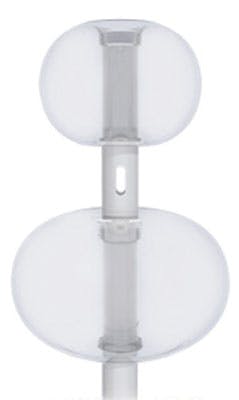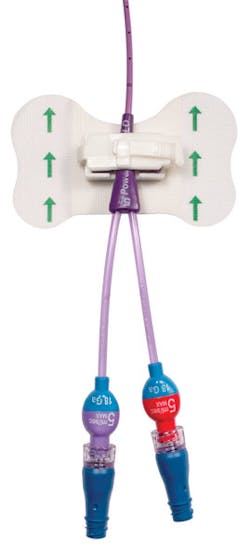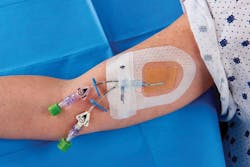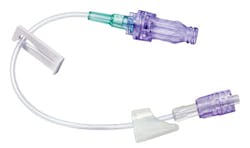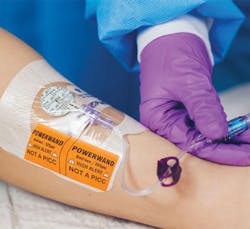Most patients have one or more catheters—most likely an intravenous (IV) or Foley urinary catheter—placed when admitted to a hospital. While their functions are different, both types of catheters are invasive and provide an avenue for bacteria to enter the body and set up infection. The number of infections for both types of catheters are high, but it isn’t because catheter placement is risky; it’s simply because there are many thousands of catheters placed each and every day. So, while only a small percentage of catheters become infected, the numbers seem astronomical. Inroads have been made against IV-catheter–related infection, but incidence of urinary-catheter–related infections is still too high.
CAUTI
Catheter-associated urinary tract infection (CAUTI) is the type of infection found most frequently in acute-care settings. Approximately 75 percent of hospital-acquired urinary tract infections (UTIs) are associated with an indwelling urinary catheter. Of approximately 1.7 million hospital-acquired infections (HAIs) annually, UTIs comprise 36 percent of the total HAI estimate,1 about 560,000 infections.2 That is an astounding figure, but not so alarming when accompanied by the understanding that approximately 15 percent to 25 percent of patients receive urinary catheters during their hospitalization. According to the Centers for Disease Control and Prevention (CDC),2 morbidity and mortality due to CAUTI is low compared to other HAIs, but their guidelines also point out that 17 percent to 69 percent of CAUTI may be preventable. That translates to 380,000 infections and 9,000 deaths that could be prevented.2 Those figures do not take into account cases of related bacteremia.
Campaigns to reduce other HAIs have been successful, but CAUTI not so much. According to CDC’s 2016 “Healthcare-Associated Infections (HAI) Progress Report,” there was no change in CAUTI overall between 2009 and 2014.3 Greg Wiita, President, Poiesis Medical, briefly explored reasons why. “As of October 2016, CAUTIs were the only HAI that demonstrated no improvement toward the Health and Human Services target of a 25 percent reduction. Per CDC, CAUTI is the leading cause of secondary bloodstream infections. Patients diagnosed with a CAUTI have a 17 to 21 percent chance of becoming septic. The issue of antibiotic resistance adds to the problem. CAUTI is the tip of the spear, and prevention tools have essentially not changed in more than a decade.” Steve Woody, CEO, Theraworx, agreed. “Whatever steps hospitals are taking to reduce CAUTI rates are having minimal impact. A recent study in the New England Journal of Medicine showed no impact in intensive care units (ICUs) in a 603-hospital sample.”4
That’s bad news on all fronts, one of which is cost. Infections are expensive. Woody referred to an article by Carol Hoffman in Healthcare Purchasing News (https://www.hpnonline.com/inside/2015-07/1507-PnP-CAUTI.html) that illustrated, and provided an example of, an analysis to determine the true cost of CAUTI in a hospital in the Chicago area.5 “Looking at actual data, that facility determined the true cost of each CAUTI exceeded $11,000, much more than the approximate $1,000 that one still hears,” said Woody. “The primary cost factor is unreimbursed expense, but Hoffman’s number did not even consider the reimbursement implications of potential hospital-acquired condition penalties or Value-Based Purchasing Withholds impacted by high CAUTI rates. We can use Carol’s approach in helping hospitals determine actual cost.”
Catheters should be used strictly as appropriate, and catheter-care protocol should be followed without fail. Hygiene is at the top of the list. Woody described how Theraworx Technology helps to reduce CAUTI. “Our product, Theraworx Technology, is a patented topical application that replaces other hygiene products used in insertion of Foley catheters and subsequent perineal cleaning, for the entire period of the catheterization. No other steps, like early removal of Foleys, need be modified to incorporate our technology. Theraworx establishes a zone of inhibition in the critical perineal area, helping maintain healthy low pH conditions in the stratum corneum and thus preserving the naturally antimicrobial acidic mantle of the skin.”
Woody referred to a study currently under peer review toward publication. “Two leading urologists have recently completed a meta-analysis of ten hospitals that switched to our product and protocol for Foley catheterized patients. We can report that, in high-risk patient populations, including neurological, cardiovascular, and trauma ICUs, with fecal and urinary incontinence, over extended pre- and post-implementation periods averaging 20 months, reduction in rates in the Theraworx group was greater than 50 percent.”
Wiita reiterated his opinion that innovation in catheters is overdue and described how Poiesis Medical addressed the issue. “Indwelling catheters have not changed in over 80 years. Poiesis Medical developed a more patient-centric solution that helps to harmonize the body’s innate immune system and ‘do no harm.’ The Duette Dual Balloon Catheter is designed to maintain the integrity of the bladder’s mucosal lining, the infection defense system that inhibits bacterial attachment to the bladder wall, and to facilitate continuous voiding. Use of the Duette catheter has been shown to improve outcomes significantly by decreasing the adverse events associated with Foley catheterization, including CAUTI. In addition to an 80-percent CAUTI reduction, clinicians have been able to sustain better results with the Duette catheter than with single-balloon catheters for two years and running.” Wiita noted that side effects—such as bladder spasms, leakage, blockage, and hematuria—were also reduced.
In support of the Duette Dual Balloon Catheter, Wiita cited two independent studies completed at level-1 trauma centers, Tampa General Hospital in concert with the University of South Florida Morsani College of Medicine6 and St. Mary’s Medical Center in Palm Beach,7 where both studies resulted in an 80 percent reduction in CAUTI.
Addressing the issue of cost, Wiita said, “By significantly reducing the incidence of CAUTI, the Duette catheter can potentially save facilities hundreds of thousands of dollars annually,” adding that Poiesis Medical gives each customer a CAUTI cost calculator, to enable the facility to use their unique data to arrive at their savings from use of the Duette catheter.
On December 12, The Joint Commission released a new R3 Report that provides the rationale and references behind its new National Patient Safety Goal (NPSG) on CAUTIs for nursing care centers, along with an updated goal for hospitals and critical access hospitals. Effective January 1, 2017, the new NPSG for Joint Commission accredited nursing care centers will require nursing care centers to “implement evidence-based practices to prevent indwelling CAUTIs.” The same NPSG, already applicable to accredited hospitals and critical access hospitals, includes several revisions to its elements of performance (EPs) to align with current scientific evidence as documented in the 2014 update to A Compendium of Strategies to Prevent Healthcare-Associated Infections in Acute Care Hospitals.
Visit https://www.hpnonline.com/new-report-on-rationale-for-new-and-revised-national-patient-safety-goals-npsgs-address-cautis/ for more information about the report including specifics on the new EPs.
CLABSI
A recent study in Antimicrobial Resistance & Infection Control revealed that inadequate adherence to central line-associated bloodstream infection (CLABSI) prevention guidelines is cause for concern worldwide.8 Their survey noted, “This international study shows that there is clear interest and awareness in the ICU community for CLABSI prevention in high and middle income countries, but implementation and adherence to existing guidelines on insertion and maintenance of CL [central lines] need to be reinforced at ICU level. Areas for improvement in practices (clinical and measurement) related to CLABSI prevention in ICUs have been identified and include: full barrier precautions, reduction of device exposure through daily assessment of CL, and utilization of data to monitor progress in preventive actions.” The study advises continuing to address factors that may be affecting the adoption and consistent use of CLABSI prevention guidelines, as well as encouraging collaboration on ICU accountability by close monitoring of infection rates, giving feedback to staff, and establishing a reliable data collection system.
In Kerry Edgar’s experience, as President of Starboard Medical Inc., “Many measures, campaigns, guidelines, and educational materials exist to assist in the prevention of catheter-associated infection; yet, despite these efforts, these highly preventable infections still exist. The most costly and critical of these infections are CL infections. CLABSIs are sometimes fatal, hard and costly to treat, and entirely preventable.”
Edgar noted that CDC’s guidelines recommend use of a sutureless catheter-securement device.9 The purpose of such devices is to minimize catheter motion, reducing the risk of bacteria migrating into the entry site. “It is well documented that movement and micro-pistoning can lead to contamination, stated Edgar. “Pathogenesis of catheter-related bloodstream infection occurs via migration of skin flora through the percutaneous entry site,9 and this can occur when the catheter pistons in and out of the site. Starboard Medical’s Clik-FIX is an innovative catheter-securement device engineered to withstand a higher pull force and reduce catheter movement and its associated complications,10 while promoting consistent practice and compliance with recommended standards.”
Edgar said that CLABSIs can cost facilities between $30,919 and $65,245 to treat.11 “Central-line dislodgement, which occurs between five to thirty-five percent of the time, is also quite costly, as catheter replacement ranges from $500 to $1,200. Clik-FIX catheter securement provides a stable hold on catheters helping to prevent movement, dislodgement, and associated complication costs.”
In 2011, Abad and Safdar reported that there are approximately 5 million central venous catheters placed every year, of which 250,000 CLABSIs result in an estimated mortality rate of between 12 percent and 25 percent annually.12 Newer statistics are more encouraging. Pat Parks, MD, PhD, Medical Director, 3M Critical and Chronic Care Solutions Division, believes that new guidelines and new technologies are addressing these infections directly with clear, positive results. “CLABSI rates in the United States have decreased by 50 percent over the last decade and represent the greatest gain in the reduction of all HAIs.3 While encouraging, the goal is to reduce such infections to zero, and this will require the continued combination of compliance with best practice and continuously improving technology.”
Parks connected the dots between catheters and BSI, describing how 3M products help healthcare givers comply with guidelines. “BSIs have two main sources, the patient’s skin at the insertion site and the IV catheter access port. Healthcare providers need to address both points of contamination. 3M offers a unique portfolio that provides both intra and extra-luminal protection, helping nurses comply with the newest industry guidelines. To protect the insertion site, 3M Tegaderm CHG Chlorhexidine Gluconate I.V. Securement Dressings conform around the catheter and hub to provide continuous CHG protection for up to 7 days. The transparent design allows these dressings to meet CDC and Infusion Therapy Standards of Practice guidelines, offering continuous visual inspection of the catheter site.”
Parks explained that, to protect the catheter line, the 3M Curos Disinfecting Port Protectors reduce microbial risk for up to 7 days, at every access point, while the passive disinfection design and bright green color support compliance by eliminating human error from scrub-the-hub techniques, allowing nurses to verify that the port is clean at a glance. Convenience is an attribute as well. “Curos disinfecting caps are available in strips that can be hung from IV poles, making them easily accessible at the bedside, helping to improve staff compliance with needleless-connector disinfection recommendations from the Infusion Nurses Society,” said Parks.
Parks related decreased CLABSI to better budget control. “Curos disinfecting caps helped one hospital reduce CLABSI infections by more than 40 percent, resulting in nearly $300,000 savings per year.”13 Another study found that use of the disinfecting caps helped reduce CLABSI rates from 1.9 to 0.5 during the one-year trial period.14
Cheryl Wozniak, Product Director, Vascular Access Systems, said that B. Braun Medical recently launched their new STEADYCare Extension Set with Wedge Catheter Stabilizer, developed to help improve stabilization and reduce catheter-related complications. “Market data shows that approximately 90 percent of hospitalized patients require an IV catheter during their hospital stay,15 while 35 to 50 percent of catheters fail during therapy.16 Failures and unscheduled restarts are caused by catheter-related complications such as infection, phlebitis, hematoma, thrombosis, and occlusion.16-18 Movement of the catheter may contribute to these complications.16-18 “STEADYCare was designed to minimize catheter movement in the vessel, maintain the catheter insertion angle, minimize catheter kinking, and reduce the patient connector’s skin contact. STEADYCare can help save costs and reduce the potential for catheter-related complications and unscheduled restarts.”
Steve Bierman, MD, Chief Medical Officer, Access Scientific, asserted that “Most things in medicine don’t get attention until there is a method of treatment and financial incentives to use that method. Bierman explained why he believes both of those elements are now in place in regard to CLABSI, as he described the virtues of the POWERWAND midline catheter. “The CDC recommends midlines instead of peripheral IVs and central lines for specified cases.12 The POWERWAND often allows clinicians to insert an evidence-based midline instead of a central line, and it allows central lines to be removed before they become infected.”19 The POWERWAND reduces central-line days, CLABSI, and other complications of vascular access, according to Bierman.
Bierman also noted that The POWERWAND saves hard- and soft-cost dollars for healthcare providers. “The two costs associated with CLABSI are the unreimbursed cost of treating the infection, and its associated penalties, and the cost of insertion of the line.” He said the POWERWAND can be at least $100 less expensive to insert than a central line.20-22 “These cost savings have been demonstrated in multiple published studies for the POWERWAND.20-22
Covering catheters
Care+Wear co-Founder and CEO Chaitenya Razdan says his company designs innovative healthwear , including fashionable PICC line covers, with the goal of enabling patients to get back to living their lives. “Its ultra-soft antimicrobial PICC line cover features a breathable mesh window (patent pending), which enables the necessary airflow to the dressing and visibility to the insertion site,” said Razdan. “The covers come in a variety of designs and colors. Developed with doctors and nurses, it is available at leading hospitals such as the VA, Cleveland Clinic, UVA, and Mayo Clinic as well as online.” The covers are FSA / HSA eligible, also sold in select Walgreens and Lori’s Gifts stores and can be purchased through Cardinal health. Co-branding opportunities and wholesale pricing are another option for larger orders.
References
1. Association for Professionals in Infection Control and Epidemiology, Inc. An APIC guide. 2008. Guide to the elimination of catheter-associated urinary tract infections (CAUTIs): developing and applying facility-based prevention interventions in acute and long-term care settings. http://www.apic.org/Resource_/EliminationGuideForm/c0790db8-2aca-4179-a7ae-676c27592de2/File/APIC-CAUTI-Guide.pdf. Last accessed: November 29, 2016.
2. Gould CV, Umscheid, CA, Agarwal RK, et al. Guideline for prevention of catheter-associated urinary tract infections, 2009. http://www.cdc.gov/hicpac/pdf/CAUTI/CAUTIguideline2009final.pdf. Last accessed: November 29, 2016.
3. Centers for Disease Control and Prevention. National and state healthcare associated infections progress report. http://www.cdc.gov/hai/progress-report/index.html. Last updated: March 3, 2016. Last accessed: December 2, 2016.
4. Saint S, Greene MT, Krein SL, et al. A program to prevent catheter-associated urinary tract infection in acute care. N Engl J Med. 2016;374(22):2111-2119.
5. Hoffman C. Trial without error: calculating the actual cost and benefits of a CAUTI therapy. Healthcare Purchasing News. July 2015. http://digital.hpnonline.com/editions/A3pza3/1507-HPN/resources/46.htm. Last accessed: November 30, 2016.
6. Beilan J, Lund T, Beane K, et al. Novel dual-balloon urinary catheters reduce catheter-associated urinary tract infections. Journal of Urology. 2016;195(4):e277. http://www.jurology.com/article/S0022-5347(16)01063-6/fulltext Last accessed: December 2, 2016.
7. Borrego A, Kristov D, Elhaddah A, et al. Eliminating catheter associated urinary tract infections in the trauma ICU: two balloons are better than one. Presented at the Southeastern Surgical Congress Annual Scientific Meeting; Atlanta, GA; February 2016. Poster.
8. Valencia C, Hammami N, Agodi A, et al. Poor adherence to guidelines for preventing central line-associated bloodstream infections (CLABSI): results of a worldwide survey. Antimicrobial Resistance & Infection Control. 2016;5:49. http://aricjournal.biomedcentral.com/articles/10.1186/s13756-016-0139-y. Last accessed: December 1, 2016.
9. O’Grady NP, Alexander M, Burns LA, et al. Guidelines for the prevention of intravascular catheter-related infections, 2011. http://www.cdc.gov/hicpac/pdf/guidelines/bsi-guidelines-2011.pdf. Last accessed: December 1, 2016.
10. Lange VR. Securement strength and motion reduction properties of a new novel engineered stabilization device. Association for Vascular Access Annual Scientific Meeting; Orlando, FL; September 2016. Poster. http://ava2016.ipostersessions.com/default.aspx?s=77-A8-B0-F2-A9-88-51-CC-45-47-9F-E1-03-F5-71-65. Last accessed: December 1, 2016.
11. Zimlichman E, Henderson D, Tamir O, et al. Health care–associated infections: a meta-analysis of costs and financial impact on the US health care system. JAMA Intern Med. 2013;173(22):2039-2046.
12. Abad CL, Safdar N. Catheter-related bloodstream infections. Infectious Disease Special Edition 2011. www.idse.net/download/BSI_IDSE11_WM.pdf. Last accessed: December 2, 2016.
13. Merrill KC, Sumner S, Linford L, et al. Impact of universal disinfectant cap implementation on central line-associated bloodstream infections. Am J Infect Control. 2014;42(12):1274-1277.
14. Ramirez C, Lee AM, Welch K. Central venous catheter protective connector caps reduce intraluminal catheter-related infection. J Assoc Vasc Access. 2012;17(4):210–213.
15. iDATA report. U.S. Market for Vascular Access Devices and Accessories. 2014:193.
16. Helm RE, Klausner JD, Klemperer JD, et al. Accepted but unacceptable: peripheral IV catheter failure. J Infus Nurs. 2015;38:189-203.
17. Wood D. A comparative study of two securement techniques for short peripheral intravenous catheters. J Intraven Nurs. 1997;20(6):280-285.
18. Schears GJ. Summary of product trials for 10,164 patients: comparing an intravenous stabilizing device to tape. J Infus Nurs. 2006;29(4):225-231.
19. Pathak R, Patel A, Enuh H, et al. The Incidence of central line–associated bacteremia after the Introduction of midline catheters in a ventilator unit population. Infect Dis Clin Prac (Baltim Md). 2015;23(3):131-134.
20. Caparas JV, Hu JP. Safe administration of vancomycin through a novel midline catheter: a randomized, prospective clinical trial. J Vasc Access. 2014;15(4):251-256.
21. Moureau N, Sigl G, Hill M. How to establish an effective midline program: a case study of 2 hospitals. J Vasc Access.2015;20(3):179-188.
22. Warrington WG Jr, Penoyer DA, Kamps T, et al. Outcomes of using a modified Seldinger technique for long term intravenous therapy in hospitalized patients with difficult venous access. J Vasc Access 2012;17;24-30.


